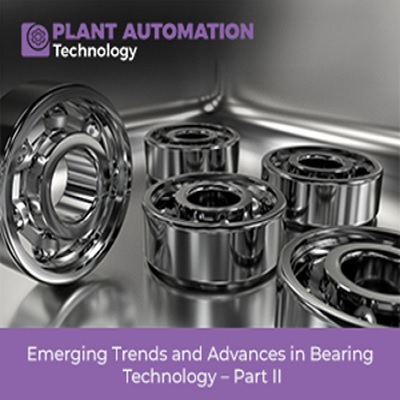Emerging Trends and Advances in Bearing Technology – Part II

Bearing technology is undergoing a remarkable transformation with several advancements and trends. These developments are driven by the continuous quest for improved performance, enhanced efficiency, and increased reliability in various industries. In this article, we delve into the exciting world of bearing technology and explore the latest innovations that are reshaping the field.
One of the key areas of progress is the integration of bearings into the Internet of Things (IoT). This integration brings forth the era of connectivity and data-driven insights. Bearings equipped with sensors and wireless communication capabilities can collect real-time performance data, enabling condition monitoring, predictive maintenance, and operational optimization. By monitoring parameters like temperature, vibration, and load, IoT-enabled bearings provide valuable information on their health status and trigger maintenance alerts when necessary. This proactive approach minimizes downtime, reduces costs, and maximizes equipment uptime.
Moreover, significant advancements have been made in condition monitoring and predictive maintenance. Leveraging sensor technology, data analytics, and machine learning algorithms, bearings can be continuously monitored for abnormalities or signs of failure. This allows predictive maintenance strategies, where maintenance activities are scheduled based on the actual bearing condition rather than predetermined intervals. By analyzing real-time data and historical patterns, maintenance teams can make informed decisions, optimize resources, and prevent catastrophic failures.
Smart bearings represent another noteworthy advancement in the field. These bearings are equipped with embedded sensors that provide real-time performance feedback. They monitor parameters like load, speed, temperature, and vibration, allowing for continuous analysis and optimization. Smart bearings can be integrated with control systems and IoT platforms, enabling centralized monitoring of multiple bearings across a facility or system. These intelligent bearings facilitate condition-based maintenance, fault detection, and performance optimization, contributing to improved overall system efficiency.
Additionally, bearing technology emphasizes sustainability and eco-friendliness. Manufacturers are exploring alternative materials, such as ceramics, composites, and bio-based materials, to minimize bearing production's environmental impact. These materials offer advantages like reduced weight, improved durability, and enhanced resistance to corrosion and wear. They align with the goal of reducing carbon emissions and resource consumption while providing performance benefits.
Furthermore, 3D printing has revolutionized bearing production. This additive manufacturing technology allows for the creation of complex and customized bearing geometries that were previously challenging or costly to manufacture. 3D printing enables rapid prototyping, on-demand production, and customization of bearings, leading to faster design iterations and reduced time-to-market. This technology also offers the potential for utilizing novel materials and material combinations, further enhancing bearing performance and durability.
As we delve deeper into these emerging trends and advancements, it becomes evident that bearing technology is on the cusp of a transformative era. IoT, condition monitoring, smart bearings, sustainable materials, and 3D printing open exciting possibilities for industries. This revolutionizes bearing design, installation, and maintenance. The following sections will provide an in-depth exploration of these developments, highlighting their benefits, applications, and implications for various sectors.
Trends and Advances in Bearing Technology
Internet of Things (IoT) integration
Incorporating the Internet of Things (IoT) brings several benefits to industries. IoT-enabled bearings can communicate with other devices and systems within the industrial environment, providing seamless integration and data sharing. This connectivity allows for real-time monitoring and analysis of bearing performance, leading to more efficient operations and maintenance practices. For example, in industries such as manufacturing or transportation, IoT-enabled bearings can provide insights into the health and performance of critical machinery, facilitating predictive maintenance and minimizing unplanned downtime. By leveraging IoT, businesses can optimize equipment usage, reduce costs, and improve productivity.
Condition Monitoring and Predictive Maintenance
Condition monitoring techniques have advanced significantly, thanks to developments in sensor technology, data analytics, and machine learning algorithms. Traditional approaches to bearing maintenance relied on predetermined schedules, which often led to unnecessary maintenance or unexpected failures. However, with condition monitoring, bearings can be continuously monitored for various parameters such as vibration, temperature, and lubrication quality. Advanced sensors can detect anomalies or early signs of failure, enabling predictive maintenance strategies. By collecting and analyzing real-time data, maintenance teams can make informed decisions about when and how to perform maintenance activities, reducing costs associated with unnecessary repairs and downtime. Predictive maintenance also extends the bearing lifespan by addressing issues before major failures. Furthermore, machine learning algorithms can analyze historical data to identify patterns and correlations, enabling more accurate predictions of bearing behavior and failure modes.
Smart Bearings and Sensor Technology
Smart bearings represent a significant advancement in bearing technology by incorporating sensor technology directly into the bearing design. These embedded sensors provide continuous feedback on wheel performance, allowing real-time monitoring and analysis. The sensors can measure parameters such as load, speed, temperature, and vibration, providing valuable insights into bearing operating conditions. By monitoring these parameters, maintenance personnel can detect abnormal behavior, identify potential faults, and take timely corrective actions. Smart bearings can also be integrated into control systems and IoT platforms. This enables the centralized monitoring and control of multiple bearings across a facility or system. This integration allows for optimized maintenance planning, early fault detection, and improved overall system performance. Additionally, smart bearings can provide valuable data for performance optimization and predictive analytics, leading to enhanced efficiency and reduced energy consumption. Sensor technology and miniaturization advancements have made it possible to embed sensors into bearings without compromising their operational integrity or lifespan.
Sustainable and Eco-Friendly Bearing Materials
In response to the growing focus on sustainability and environmental responsibility, bearing manufacturers are exploring sustainable and eco-friendly materials for bearing production. Traditional bearing materials, such as steel, are energy-intensive to produce and contribute to carbon emissions. Alternative materials offer environmentally friendly solutions with improved properties. Ceramic bearings, for example, are made from silicon nitride or zirconia. These materials offer benefits like lighter weight, increased hardness, and enhanced corrosion resistance. These materials also exhibit lower friction and wear characteristics, leading to improved overall bearing performance. Composite materials, which combine various fibers with resin matrices, provide lightweight and durable bearing solutions while reducing metal resource reliance. Bio-based materials, derived from renewable sources like plant-based polymers, are currently being explored for bearing applications. These materials are recyclable and biodegradable, further reducing their environmental impact. Sustainable bearing materials align with environmental goals but also contribute to improved energy efficiency and lower maintenance requirements. This makes them a preferred choice for industries aiming for greener and more sustainable practices.
3D Printing and Customized Bearing Solutions
The advent of 3D printing, or additive manufacturing, has revolutionized the production of complex components, including bearings. 3D printing enables the creation of intricate bearing geometries that were previously challenging or costly to manufacture using traditional methods. By building up layers of material according to a digital design, 3D printing offers flexibility and customization possibilities for bearing production. Complex bearing designs, such as those with specialized grooves or internal structures, can be easily created. Customized bearing solutions can be tailored to specific applications, optimizing performance and reducing assembly complexity. Additionally, 3D printing allows for rapid prototyping, enabling iterative design improvements and faster time-to-market for existing bearing designs. 3D printing also eliminates extensive inventory, as bearings can be produced as needed, reducing storage costs and waste. The ability to manufacture spare parts on-site using 3D printing technology minimizes the downtime associated with sourcing and shipping replacement parts. Furthermore, 3D printing offers the possibility of utilizing novel materials and material combinations, leading to improved bearing performance and durability.
Conclusion
Bearing technology trends and advancements, such as IoT integration, condition monitoring, smart bearings, sustainable materials, and 3D printing, are reshaping the industry. These innovations offer improved performance, reliability, and greener solutions for various sectors. By leveraging connectivity, data analytics, and customization, businesses can optimize maintenance practices, reduce costs, and improve overall equipment performance. Furthermore, sustainable bearing materials contribute to environmental responsibility while providing enhanced properties. 3D printing's flexibility and customization capabilities enable faster prototyping and on-demand bearing production, minimizing downtime and increasing operational efficiency. As these technologies continue to evolve, bearing technology will play an increasingly vital role in driving innovation and transforming industries.







